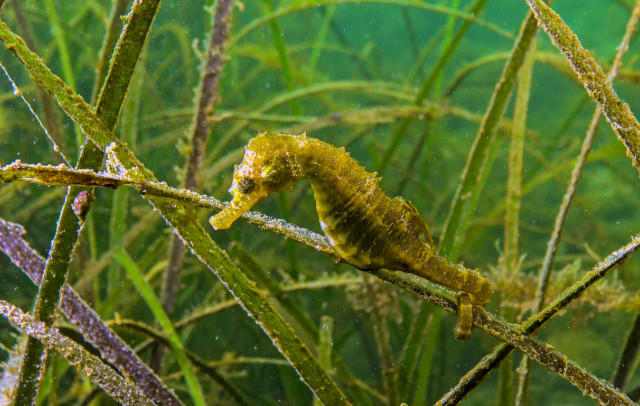It’s all about the snouts in the two types of seahorse which you’ll find off the coast of southern England - the short and the long!
You’re probably asking yourself what have our freshwater rivers got to do with these saltwater dwelling creatures, but river water quality has a huge impact on the habitat of these tiny animals.
You might associate the majestic seahorse with tropical waters, but we are lucky enough to have both short-snouted and long-snouted seahorses here in the English Channel. Easily distinguished by, you’ve guessed it, the length of their snouts, the long-snouted seahorse also bears a fleshy “mane” along its back, whereas the short-snouted seahorse is “maneless”.
Using their strong tails to grip to seaweed or seagrass, these fish (yes, they are officially a type of fish) are terrible swimmers, so are dependent on things to cling to for security and currents to help them get around. They also don’t have any teeth so instead suck up their food such as plankton and small shrimp. Like all seahorses they are the only animal to have a truly reversed pregnancy. The female transfers her eggs to the male who self-fertilises them before keeping them in his brood pouch to then birth the live fry when ready.
Providing shelter for young to grow, as well as anchors for all ages of seahorses to cling to, kelp (a brown flat bladed seaweed) in the English Channel is a vital part of a balanced sea habitat. Sadly since the 1980s Sussex kelp beds had declined by 96%, having a huge impact on a myriad of sealife, including our underwater horsey friends.
The Sussex Kelp Project was formed in 2021 to start work on identifying what was causing this decline. With a nearshore trawling ban put in place to help keep sediment stir-up to a minimum, other investigations identified that sediment and pollution washing into the sea from our rivers was having a damaging impact on kelp and marine life.
Intense arable agricultural activities and insensitive management along the river banks causes soil erosion, leading to more soil and often fertilisers slipping into the river water. Pollution from roads and wash off from fields also contaminates the river water, which then flows into the sea contaminating our coastal waters.
Sediment in the seawater reduces the amount of light reaching the kelp, hindering its growth. While pollution in the water can affect the nutrients kelp and sea creatures are exposed to often affecting food sources or even causing direct harm or death to the animals.
With smaller or less kelp growing, marine animals lose food sources and a place to stay safe and create a home. One kelp can provide a multi-dimensional habitat for around 80,000 individual animals! Isn’t that amazing!
With the short and long-snouted seahorse on the vulnerable list, it is a stark sign of how the life quality of even the tiniest sea creatures on our shorelines can be affected by the quality of our river water.
